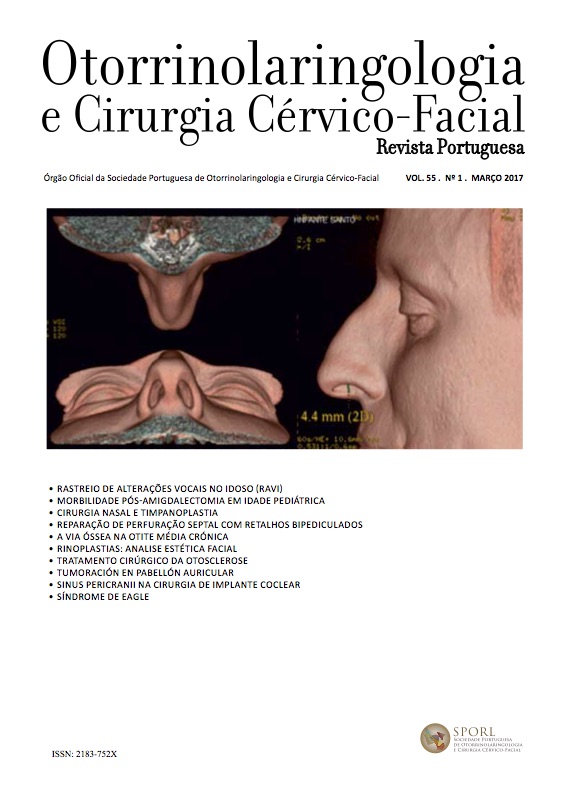Septal perforation repair technique with bipedicle flaps: 3 cases report
DOI:
https://doi.org/10.34631/sporl.360Keywords:
septal, perforation, brige, flapsAbstract
Introduction: The nasal septum perforation results from interruption of bilateral septal mucoperichondrium, with subsequent necrosis and destruction of the underlying cartilage. There are several possible causes, but it is most often iatrogenic (due to septoplasty). Although it is often assymptomatic, it can cause significant symptoms such as nasal obstruction, nasal crusting, bleeding and whistle. Its surgical repair, as an alternative to the septal button, requires a lot of experience and technique, with several methods described in the literature. In our department we use bridge flaps, preferably bilaterally, in order to ensure the closing of the perfuration.
Material and Methods: We describe 3 cases operated in the service, using the same technique. First, a perforation with 3 mm of diameter caused by septoplasty; second, a perforation with 5 mm of diameter, caused after FESS for epistaxis control; the third, of unknown cause, with a perforation with 11 mm of diameter.
Results: We achieved complete closure in the 2 patients with the smaller perforations. The third patient has a small residual perforation, at 4 months postoperatively. There was resolution of the symptoms in all patients.
Conclusions: The septal perforation is responsible for important symptoms and its closure is a desirable option against the placing of a septal button. There are several techniques. In this study we describe the use of bipedicle flaps with good results.
Downloads
References
Pignataria S, Nogueira J, Stamm A. Endoscopic "crossover flap" technique for nasal septal perforations. Otolaryngology - Head and Neck Surgery, vol 142, 2010
Metzinger S, Metairie LA, Guerra A. Diagnosing and treating nasal septal perforations. Aesthetic Surg J 2005;25:524-529
André RF, Lohuis P, Vuyk H. Nasal septum perforation repair using differently designed, bilateral intranasal flaps, with nonopposing suture lines. J of Plastic, Reconstrcutive & Aesthetic Surgery 2006;59:829-834
Sang-Wook K, Chae-seo R. Nasal septal perforation repair: predictive factors and systematic review of the literature. Curr op otolaryngol. 2012;20:1-8
Fairbanks DN. Closure of nasal septal perforations. ARch otolaryngol Head Neck Surg 1980;106:509-13
Kridel RWH, Appling D, Wright W. Septal perforation closure utilizing the external septorhinoplasty approach. Arch Otolaryngol head Neck Surg 1986;112:168-72
Arnstein DP, Berke GS. Surgical considerations in the open rhinoplasty approach to closure septal perforations. Arch otolaryngol Head and Neck surg 1989;115(4):435-8
Goodman WS, Strelkzow VV. The surgical closure of nasoseptal perforations. Laryngoscope 1982;92:121-4
Romo TR, Foster CA, Korovin CS. Repair of nasal septal perforation utilizing the midface degloving technique. Arch Otolaryngol Head Neck Surg 1988;114:739-42
Tasca I, Compadretti G. Closure of nasal septal perforation via endonasal approach. otolaryngol Head Neck Surg 2006;135:922-927
Gillies H, Millard DR. The principles and art of plastic surgery. Boston: Little, Brown and company; 1957 p.50-4
Seiffert A. Die operation and Nase, Mund und Hals. Leipzig: Barth; 1936. p.146-8
Seeley RC. Repair of septal perforations. Laryngoscope. 1949;59:130-46
Schultz Coulon HJ. Three layer repair of nasoseptaldefects. Otolaryngol Head Neck Surg. 2005;132:213-8
Teymoortash A, Werner JA. Repair of nasal septal perforation using a simple unilateral inferior meatal mucosal flap. Journ Plastic, Reconstructive Aestethic Surg 2009; 62:1261-1264
Park JH, Kim DW, Jin HR. Nasal septal perforation repair using intranasal rotation and advancement flaps. Am J Rhinol Allergy 2013;27:42-47
Neumann A, Morales-Minovi C, Schultz-Coulon H. Closure of nasal septum perforations by bridge flaps. Acta Otorrinolaringol Esp. 2011;62(1):31-39
Sclafani A. Repair of large nasal septal perforations via the external rhinoplasty approach. Op Tech Otolaryngol 2001;12:20-24
Kridel RWH. Considerations in the etiology, treatment and repair of septal perforations. Facial Plast Surg Clin North Am 2004;12:435-50
Kridel RW, Foda H, Lunde KC. Septal perforation repair with acellular human dermal allograft. Arch Otolaryngol Head Neck Surg 1998;124(1):73-8
Wainwright DJ. use of an acellular allograft dermal matrix (Alloderm) in the management of full-thickness burns. Burns 1995;21:243-248
Schulman J. Clinical evaluation of an acellular dermal allograft for increasing the zone of attached gingiva. Pract Periodont Aesthet Dent 8:201-208, 1996
Saradeses-Garcia A, Sulsenti G, Lopez-Amado M et al. Septal perforation closure utilizing the backwards extraction-reposition technique of the quadrangual cartilage. J Laryngol Otol 1999;113:721-4






